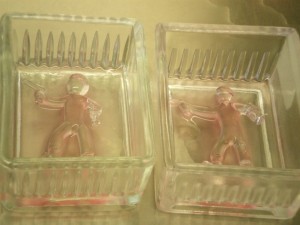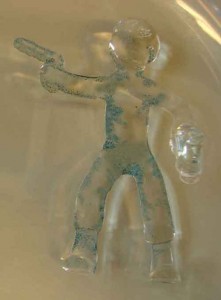BioArtist Alicia King talks about culturing skin tissue, residencies and the ethics of BioArt.
Describe the focus of your arts practice
I’m interested in ethical issues around mutations between biotechnology, humans, animals and the environment. The idea of the physical, stable body becoming fluid and transformative amazes me; although this excitement for (seemingly) limitless potential also comes heavily laden with the reality of the exploitation of living things, which seems to render the idea of ‘life’ and ‘growth’ inane. I also work with non-living materials, which allude to organic growth-like forms, generally outside of the everyday category of the living.
You have recently received clearance to do create work using your own skin tissue. Why?
As part of my PhD, I received clearance from UTAS to undergo a shave biopsy, which involves removing a small section of my skin that I will take to the Lab to be grown into 3D form. Later I will return to SymbioticA for a short residency to specifically learn how to culture primary human tissue. The project is mainly focused upon ideas to do with ownership and rupturing of the physical body and the impact of the resulting fluidity upon embodiment.
How did you become involved in BioArt?
During my Honors in Fine Art in Hobart I was researching biotech developments and how they might effect the human/animal divide, when I came across SymbioticA and excitedly contacted them; soon finding myself in Perth undertaking the Art and Life Manipulation unit, run by Oron Catts and Ionat Zurr. Here I did a crash course in tissue culturing and created my first bio art piece The Miniature Hybrid Project (MHP), for which I had a tiny glass chimera made and cultured human and mouse tissue over the surface. Soon after I was offered a PhD scholarship at UTAS, in Hobart where I started artistic research in the School of Medicine Pathology Department, with the assistance of Dr Greg Woods.
Tell us about your recent residency in Amsterdam.
I went to The Arts and Genomics Centre, based at the University of Leiden in The Netherlands to pursue a project, Go forth and multiply. The project involves the phenomenon of the HIV virus, using visual markers in human tissue infected with HIV, to make the infection visible to the naked eye. I collaborated with Australian artist Eden St James and Dutch Immunologist Lot de Witte, from the Vrij University, in Amsterdam. Eden and I plan to develop video animation works from laboratory footage and sculptural pieces with the intention for it to be exhibited in a contemporary art context as well as being developed for public and school education awareness programs around HIV/AIDS.
Bio art can create a lot of controversy and ethical debates; what is your stance?
From my understanding, most bio art being produced is coming from an ethical premise, whether its biotech itself, or human, animal, hybrid bio developments, social or political issues. For me, it’s mostly to do with body boundaries, ownership and the human/animal relationship.
Alicia’s Residency at The Arts and Genomics Centre was assisted by ANAT, Arts Tasmania and Arts and the Environment. Special thanks also to The Immunology Dept at Vrij University Amsterdam for making the Go Forth and Multiply possible.
Amanda Matulick
An enthusiastic ‘geek-in-learning’, Amanda‘s passion for digital communication and online environments has seen her transition Filter Magazine from hard format into digital, optimising the amount of value added content. As well as managing ANAT’s communications and marketing strategies, she is regularly invited to speak and write about the impact of digitisation on arts publishing.
Read More
 This work is licensed under a Creative Commons Attribution-ShareAlike 3.0 Australia.
This work is licensed under a Creative Commons Attribution-ShareAlike 3.0 Australia.









[...] an interview with Alicia in Filter [...]